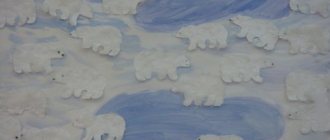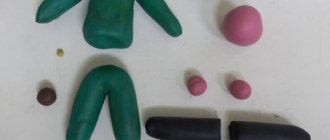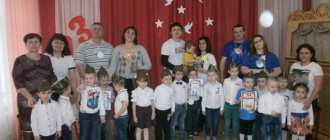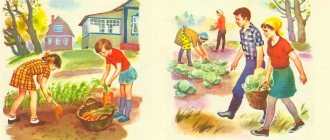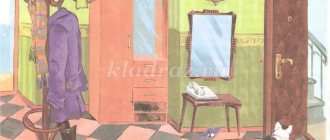Lesson summary “Cut and paste what kind of building you want”
02.12.2021
Kurseitova Z.S.
Application Topic: “Cut out and paste what kind of building you want”
Target:
Forming in children the ability to create a variety of images of buildings in applications. Develop imagination, creativity, sense of composition and color. Practice cutting strips in a straight line, squares diagonally, etc. Learn to think through the selection of parts according to shape and color. Reinforce techniques for careful gluing. Enrichment of the vocabulary of words, development of speech and memory, thinking.
Tasks:
Develop imagination, creativity, sense of composition and color. Continue to practice cutting strips in a straight line, squares diagonally, etc. Learn to think through the selection of parts according to shape and color. Reinforce techniques for careful gluing. Develop imagination. Cultivate interest in class. Activate speech.
Material:
Designer parts (wooden and plastic, different shapes: cubes, bricks, triangular prisms). Strips of paper of different colors, sheets of paper, scissors, glue, glue brush, napkin. Wonderful bag, construction set details (cube, brick, triangular prism).
Greetings:
Let's stand together in a circle,
You are my friend and I am your friend
We are not too lazy to say hello,
Hello everyone and good afternoon!
Educator:
Guys, this morning the postman brought us a wonderful bag, do you want to know what was hidden in the wonderful bag?
Let's take a look together. Children take out construction set parts from the bag.
What is this? (constructor details)
Children examine the details, clarify the shape and color of the parts (cube, brick, triangular prism).
Guys, what can be built from these parts (house, garage, bridge).
Invite several children to build various buildings. (While the children are building, clarify what parts are used for construction).
Consider and clarify with children what geometric shapes are the basis of the construction set parts (cube - square, brick - rectangle, trihedral prism - triangle).
education lesson PROCEEDINGS
NOD:
Guys, let’s go to the tables
Finger gymnastics
House
I want to build a house, (Fold my hands like a house and raise it above my head) So that there is a window in it, (Join the fingers of both hands in a circle) So that the house has a door, (We connect the palms of our hands together vertically) So that a pine tree grows nearby. (We raise one hand up and “spread” our fingers) So that there is a fence around, The Dog guards the gate, (We join our hands in a lock and make a circle in front of us) The sun was out, it was raining, (First we raise our hands up, our fingers are “spread”. Then the fingers lower it down, make “shaking” movements) And the tulip bloomed in the garden! (Put your palms together and slowly open your fingers - “tulip bud”)
Educator: Children, before you and I start creating our own buildings, let’s remember how to hold scissors correctly; first we create the entire building on a sheet, and only then glue it
Invite the children to start working, cut out and paste a beautiful building, whatever they want. The houses are one and two storey. We also glue the windows and doors. Take a brush and dip the brush into the glue. We turn our houses over and apply glue to the paper. Holding it with our second hand, we paste our construction onto paper. And so we sequentially glue on the rest of our buildings.
Independent work of children (I supervise work with scissors)
At the end of the lesson, review the work. The children tell us what they did. Choose the most interesting buildings. Help children who have difficulty completing tasks.
Reflection:
Educator:
What did we do today? Children's answers
What shape were our houses, and how many storeys were there? Children's answers.
What color are our houses? Children's answers.
Demonstration and examination of works.
Well done!
Lesson notes
Class
(title)
Application “Cut out and paste what you want”
Tasks:
Educational:
teach children to conceive an image and to subordinate subsequent work to the plan.
Educational:
develop creativity and imaginative perception.
Educational:
cultivate independence.
Lesson structure:
introductory part
Creating a problem situation
Target setting
Motivation for activity
- Guys, look who it is? These are the three sad little pigs. What happened to you, piglets?
“We had trouble - an evil wolf destroyed our house, we managed to escape, but now we don’t have a house.
- Help us please.
- Guys, can we help the poor homeless piglets? How?
main part
Designing solutions to a problem situation.
— Guys, what does the house consist of? (walls - rectangular or square, roof - triangular, windows - square or rectangular, doors - rectangular).
— What materials can you build a house from?
- If a house is built from straw, then we will call it thatched; made of wood – wooden; from brick - brick, from concrete - concrete, from stone - stone.
- Guys, we will build a warm, spacious, bright, cozy, new, modern and beautiful house for three little pigs.
— On your tables there are scissors, glue, a glue brush, and a napkin. Multi-colored strips of paper - from them you will cut out all the details necessary for the house. Glue the details onto sheets of paper.
The teacher reminds that scissors are not a toy. They should be used only for their intended purpose and only at the table.
Safety precautions when working with scissors :
— Scissors cannot be taken without permission.
— Scissors should not be placed on the edge of the table, they can fall and injure you.
— You cannot run your hands over the open blades of the scissors, they are sharp and you can get hurt.
— Scissors cannot be passed with the blades forward, pass the scissors with the rings forward.
— Scissors should not be held with the blades up or towards you, as you may stumble and get hurt.
— You can’t cut with scissors on the go.
— When working, carefully monitor the cutting direction.
- Do not cut with scissors as you go.
— While working, hold the material with your left hand so that your fingers are away from the blade.
Safety precautions when working with glue
1. Handle the glue with care. Glue is poisonous!
2. Do not let glue get on your face, especially your eyes.
3. If glue gets into your eyes, rinse them immediately with plenty of water.
4. After finishing work, be sure to wash your hands and arms.
5. When working with glue, use a napkin.
The teacher demonstrates cutting techniques: we cut narrow and wide strips in a straight line, thus creating walls, doors, and windows.
— The triangle for the roof can be cut in different ways. The simplest technique is to cut the square in half diagonally with an oblique cut from one corner to the opposite.
- Go to your places, guys.
Finger gymnastics House on the Mountain.
On the mountain we see a house. (Fold the house with your hands)
Lots of greenery around. (Wave-like movements of the hands)
Here are the trees, here are the bushes (Make “trees” and “bushes” with your hands)
Here are fluffy flowers! (Use your fingers to show a bud - a blossoming flower)
There is a fence surrounding everything. (Show a “fence” of fingers in front of you)
Behind the fence is a clean yard. (Stroke the table with your palms)
We open the gates (Use your hands to show the gates, the gates open)
We quickly run up to the house. (Run your fingers across the table)
We knock on the door: “Knock, knock, knock!” (Knock on the table with your fists)
Someone is coming to our door. (Place your palm to your right ear and listen)
We came to visit a friend
And they brought gifts. (Stretch your arms forward, as if presenting something)
Independent activity of children (I supervise work with scissors)
I help children as needed.
final part
Performance analysis
Summing up the lesson
- Guys, you are so great! Look what houses you made!
- What did we do today?
— Was it difficult to make the buildings?
- Who came to visit us? For what?
-The three little pigs really liked your work. They are very grateful to you. And they say goodbye!
April
Lesson 71. Drawing “Fairytale house-teremok”
Program content. Teach children to convey the image of a fairy tale in a drawing. To develop imaginative ideas, imagination, independence and creativity in depicting and decorating a fairy-tale house. Improve decoration techniques.
Lesson 72. Modeling “Bowls for Three Bears”
Program content . Teach children to sculpt objects of the same shape, but different sizes. Practice making bowls. Practice sculpting techniques: rolling and flattening, deepening by pressing, smoothing edges with your fingers. Learn to separate lumps corresponding to the size of future objects. Learn to create objects for a dramatization game based on a fairy tale.
Lesson 73. Application “Riddles”
Program content. Strengthen children's ability to correlate flat geometric shapes with the shape of parts of objects, create an image from ready-made parts, and independently cut out small parts. Practice careful gluing. Develop creativity, imaginative perception, imaginative ideas, imagination.
Lesson 74. Modeling “Lamb” (In the image of the Filimonov toy)
Program content. Introduce children to Filimonov toys (birds, animals). Induce a positive emotional attitude towards them. Learn to highlight the distinctive features of these toys: beautiful smooth shape; bright, elegant stripes. Make you want to make such a toy.
Lesson 75. Drawing “My beloved sun”
Program content. Develop figurative ideas and imagination of children. Reinforce previously learned drawing and coloring techniques.
Lesson 76. Application “Cut and paste what you want”
Program content. Teach children to conceive an image and subordinate subsequent work to the plan. Learn to cut out rectangular and round parts of objects, small parts from paper. Foster independence and creativity.
Lesson 77. Drawing “Your favorite doll”
Program content. Teach children to create an image of their favorite toy in a drawing. Strengthen the ability to convey the shape, location of parts of the human figure, their relative size. Continue learning to draw large, on the entire sheet. Practice drawing and painting. Continue learning to look at pictures and justify your choice.
Lesson 78. Modeling “Cup”
Program content. Teach children to sculpt dishes using the techniques of rolling, pressing and leveling the edges of the mold with their fingers. Practice connecting parts by pressing and smoothing the fastening points.
Lesson 79. Drawing “The House You Live In”
Program content. Teach children to draw a big house, convey the rectangular shape of the walls, rows of windows. Develop the ability to complement the image based on impressions of the surrounding life. Encourage children to want to look at their drawings and express their attitude towards them.
Lesson 80. Modeling “Dishes for dolls”
Program content. Strengthen children's ability to sculpt dishes. Practice sculpting techniques. Foster activity, independence and accuracy in work. Continue to develop teamwork skills.
March
Lesson 61. Drawing “Beautiful flowers have bloomed”
Program content. Teach children to draw beautiful flowers using a variety of shaping movements, working with the whole brush and its end. Develop aesthetic senses (children should carefully select paint colors), a sense of rhythm, and ideas about beauty.
Lesson 62. Application “A beautiful bouquet as a gift to all women in kindergarten” (team work)
(Option: Decorative applique on a square)
Program content. Cultivate a desire to please others, to create something beautiful for them. Expand children's figurative ideas, develop the ability to create images of the same objects in different, variable ways. Continue to develop team creativity skills. Induce a feeling of joy from the created image.
Lesson 63. Modeling “Bowl”
Program content. Teach children to sculpt using already familiar techniques (rolling out a ball, flattening) and new ones - pressing and pulling the edges, leveling them with your fingers.
Lesson 64. Application “Cut out and paste what is round and oval”
(Option: Application “Cut out and stick whatever toy you want”)
Program content. Teach children to choose a topic of work in accordance with certain conditions. Develop the ability to bring your plan to completion. Develop creativity and imagination. Practice cutting the corners of a rectangle and square, rounding them. Strengthen your neat gluing skills.
Lesson 65. Decorative drawing “Let’s decorate the doll’s dress”
Program content. Teach children to make a pattern from familiar elements (stripes, dots, circles). Develop creativity, aesthetic perception, imagination.
Lesson 66. Modeling “Little Goat”
Program content. Teach children to sculpt a four-legged animal (oval body, head, straight legs). Strengthen sculpting techniques: rolling between the palms, attaching parts to the sculpted body of the animal, smoothing out the fastening points, pinching, etc. Develop sensorimotor experience.
Lesson 67. Drawing “The little goats ran out for a walk on the green meadow”
Program content. Continue teaching children to draw four-legged animals. Reinforce the knowledge that all four-legged animals have an oval body. Learn to compare animals, see what is common and what is different. Develop imaginative ideas, imagination, creativity. Learn to convey fairy-tale images. Strengthen the techniques of working with a brush and paints.
Lesson 68. Modeling “The bunnies jumped out into the clearing to nibble the green grass”
Program content . Teach children to sculpt an animal; convey the oval shape of his body, head, ears. Reinforce the techniques of sculpting and connecting parts. Develop the ability to create a collective composition. Develop figurative ideas and imagination.
Lesson 69. Drawing “How we played the outdoor game “Homeless Hare””
Program content. Develop children's imagination. To develop the ability to convey the plot of the game and images of animals in a drawing using expressive means (shape, position of an object in space). Continue to develop interest in a variety of creative activities.
Lesson 70. Modeling “Make what you like”
Program content. To develop children’s ability to evaluate the impressions received, to determine their attitude to what they saw and learned. To form a desire to reflect received impressions in artistic activity. Strengthen children's desire to create interesting images in modeling, using previously learned techniques.
